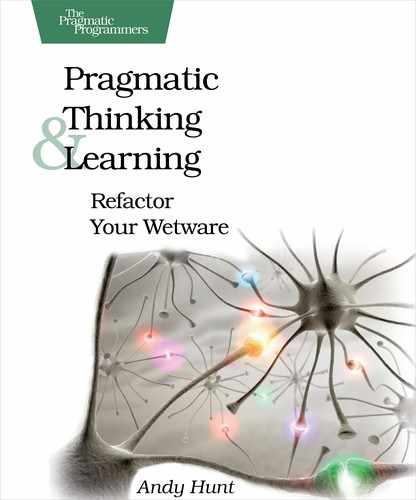Defocus to Focus
Some problems yield only to a less conscious approach. And that brings up an interesting question. What counts as “work” or as “effort”? Are you “cooking” when you’re letting something marinate for twelve hours? Are you “working” when you’re sitting around thinking about a problem?
Yes, is the short answer. Creativity does not function on a time clock and does not generally yield results when pressured. In fact, the situation is quite the opposite: you need to let go of the problem with your conscious mind and let the problem sit in the marinade of thought for a while.
Tom Lutz, author of Doing Nothing: A History of Loafers, Loungers, Slackers, and Bums in America [Lut06], says, “It’s very clear that for a lot of people the creative process includes an enormous amount of sitting around doing nothing.” But to try to clarify that position, it’s not the idea of not doing anything; it’s the idea of not doing something.
Don’t do something.
Now this might present a problem in a post-industrial society. This kind of critical “thinking time” is generally unrecognized and unrewarded in most corporations. There’s a widespread misconception that as a programmer (or other knowledge worker), if you’re not typing on a keyboard, then you’re not working.[140]
Handing work over to the unconscious works only if you have some data to work on. You first need to “fill up,” as it were, with what facts you have.
Lutz goes on to say that everyone has their own version of the “marinade,” that is, some way of letting their thoughts stew (I’ve always been fond of mowing the grass, for instance). We’ve talked about how the R-mode needs a chance to work on the material, but there’s a related idea that comes from the “multiple drafts” model of consciousness.
In Consciousness Explained [Den93], Dr. Daniel Dennett proposes an interesting model of consciousness. Consider that at any given moment, you have multiple rough drafts of events, thoughts, plans, and so on, constructed in your mind. Dennett defines “consciousness” as the single draft that has the most brain cells or processing activity in the brain at a single moment.
Think of the multiple drafts like different clouds of lightning bugs scattered throughout the brain.[141] Most of the different groups/clouds flash indiscriminately; a few flash together as a whole cloud. When several of the clouds flash in sync with each other, they in essence take over the brain for a brief moment. That is consciousness.
Suppose your senses register some new event. Dr. Dennett says, “Once a particular observation of some feature has been made by a specialized, localized portion of the brain, the information content thus fixed does not have to be sent somewhere else to be rediscriminated by some ‘master’ discriminator…these spatially and temporally distributed content-fixations in the brain are precisely locatable in both space and time, but their onsets do not mark the onset of consciousness of their content.”
Multiple drafts form consciousness.
In other words, recognition has not yet reached a conscious level. He continues, “This stream of contents is only rather like a narrative because of its multiplicity; at any point in time there are multiple ’drafts’ of narrative fragments at various stages of editing in various places in the brain.” This flow from draft to draft creates what we perceive as narrative.
Dennett’s theory is a very interesting alternative to the so-called Cartesian Theater model, where you assume there is a master center of consciousness that directs the activities of the brain and hence you. It’s sort of like Mike Meyers and Mini-Me or a movie theater screen where consciousness plays out.
But that’s probably not the case; the multiple-draft theory supports a more distributed model of processing that’s more in line with current research. There is no single source or executive monitor that’s calling the shots. Instead, whichever areas are activated together right now form your consciousness. That makes consciousness a bottom-up, self-organizing, perhaps even emergent property.
Let’s return to the idea of marinating; as hard as it might be to accept, you need time to allow these multiple drafts to ferment, percolate, and develop. One line of thought will be “current” and experienced as consciousness, but that doesn’t mean that all the other drafts are discarded or irrelevant.
Have you heard of the consultant’s Rule of Three?[142] In general, if you can’t think of three ways a plan can go wrong or think of three different solutions to a problem, then you haven’t thought it through enough. You can think of the multiple-drafts model in that light; let at least three alternative ideas ferment and come to consciousness. They are in there already; just let them grow and ripen.
And, yes, that might just mean sitting around and doing nothing. Feet up on the desk. Humming. Eating a crunchy snack.
| Recipe 40 | Make thinking time. |
So, now what do you do with all of this great stuff? Just as you want to go from R-mode to L-mode to productize learning, you want to work with knowledge in a more deliberate way.
| Next Actions |
-
What’s your favorite recipe for mental marinade? Have you tried others?
-
Have you criticized others for their time spent in the mental marinade? What will you do differently now?
-
Have you been criticized for marinating? How will you respond the next time it happens?
